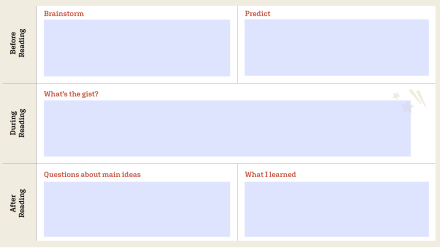Download a Graphic Organizer
The Collaborative Strategic Reading (CSR) strategy teaches students to monitor their comprehension while reading and to work cooperatively to gain a deeper understanding. Before, during, and after reading students work with a partner or in small groups to:
- Preview the Text
- Clicks or Clunks
- Clicks: Words students automatically know and understand
- Clunks: Words that make no sense and need to be figured out
- Get the Gist
- Students explain in 10 words or less what the most important ideas or events were in the reading.
- Wrap Up
- What questions do your students have about what they read? They should generate and answer questions as a group.
Why use the CSR strategy?
Teachers often love the CSR approach because of its inherent flexibility for use across units of study and disciplines, and high engagement of students. It promotes self-monitoring while reading but also problem solving with peers and resilience as learners.
How to create and use the strategy
- Prior to reading, students should be placed into small groups and the CSR strategy reviewed. If any of the four parts of the CSR strategy are unfamiliar to your students, take the time to explain and model how to preview the text or write a gist. A little modeling can ensure the CSR strategy is used successfully with your students.
- Download and distribute our CSR Learning Log (fillable pdf) to your students. CSR learning logs are used to help students keep track of learning during the collaboration process. Students think about what they are reading and write down questions/reflections about their learning. The completed logs then provide a guide for follow-up activities and evaluation methods.
- Walk students through expectations for filling out their logs. Planned activities for logs might include impromptu writing, note taking, or diagram drawing.
- Remind students that CSR learning logs can become excellent study guides to review information for tests.
- As students begin using their learning logs and discussing their ideas, you want to monitor entries, respond to questions, and clarify confusions.
Strategy in action
An underlying foundation to the CSR strategy is collaborative discussions. Let’s listen to reading expert, Dr. Doug Fisher discuss tips on how to conduct effective collaborative conversations within your classroom.
Tips for success
- As students dig into their reading and small group discussions, remember that your role is more of a coach. You want students to drive the discussions but you can help guide them if they get off-track.
- The foundation of the CSR strategy is small group, collaborative learning, therefore you want to group students intentionally and strategically.
- Remind students that they are working together to gain a better understanding. One person should not come up with all the questions or answers.
